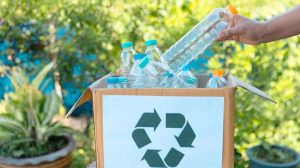Most companies that switch to recycled polythene do it to avoid the Plastic Packaging Tax. And while using 30% recycled content helps you stay compliant, it shouldn’t be the end goal.
The UK’s Plastic Packaging Tax, introduced in April 2025, charges £223.69 per tonne on plastic packaging containing less than 30% recycled content.
Whilst this has driven initial adoption of recycled materials across British industry, forward-thinking businesses are recognising that compliance alone won’t deliver the competitive advantages that genuine sustainability leadership provides.
If you’re serious about hitting your sustainability targets, you’ll need to do more than just meet the minimum. That’s where high-recycled-content products like PolyPCW™ come in.
With up to 100% recycled content, they let you go further, reducing your environmental impact in ways that can be measured, reported, and used to improve your supply chain performance.
How Recycled Polythene Helps Businesses Exceed Sustainability Targets?
The Business Case for Going Beyond Compliance

British businesses are facing increasing pressure from multiple stakeholders. Major retailers like Tesco, Sainsbury’s, and ASDA have committed to ambitious plastic reduction targets, often requiring suppliers to demonstrate measurable environmental improvements.
Meanwhile, institutional investors are scrutinising environmental credentials more closely, with sustainability performance increasingly influencing investment decisions and credit ratings.
The upcoming Corporate Sustainability Reporting Directive (CSRD), which will affect large UK companies operating in the EU, requires detailed environmental impact reporting.
Even post-Brexit, many British firms find themselves subject to these regulations through their European operations or supply chain relationships.
Reduce Your Carbon Footprint with High-recycled-content Polythene
Switching to recycled polythene is one of the simplest ways to cut carbon emissions in your supply chain, especially in packaging. Virgin polythene requires fossil fuel extraction and high-temperature processing. In contrast, recycled polythene uses existing waste and significantly less energy to produce.
According to industry data, recycled polythene can reduce CO₂ emissions by up to 87% compared to virgin material.
This figure becomes even more important if you’re reporting against Scope 3 emissions, which include packaging sourced from external suppliers.
The carbon intensity of virgin polythene production is approximately 1.8-2.0 kg CO₂ equivalent per kilogram of material. This includes emissions from oil extraction, refining, polymerisation, and transport.
Recycled polythene, by contrast, typically generates 0.5-0.8 kg CO₂ equivalent per kilogram, a reduction achieved through eliminating the need for virgin feedstock and utilising lower-energy mechanical recycling processes.
For a typical UK distribution centre using 50 tonnes of polythene packaging annually, switching to high-recycled-content material could save 60-75 tonnes of CO₂ equivalent, roughly equivalent to taking 15-20 cars off British roads for a year.
PolyPCW™ offers up to 100% recycled content, meaning you can maximise emissions savings without changing your packaging format or compromising performance.
It’s a direct way to reduce your carbon footprint, and unlike offsetting schemes, it’s measurable, visible, and built into your product packaging.
Turn Plastic Waste into a Resource, Not a Problem

Many businesses still treat plastic waste as something to manage or reduce. But with the right materials, you can treat it as a resource instead. Recycled polythene made from post-consumer waste (PCW) is a clear example of this shift.
Britain generates approximately 2.4 million tonnes of plastic packaging waste annually, according to WRAP data. Of this, roughly 44% is currently recycled, leaving significant volumes that could be diverted from landfill or energy recovery into valuable secondary materials.
The government’s Resources and Waste Strategy aims to increase this recycling rate to 65% by 2035, creating both opportunity and imperative for businesses to engage with recycled content.
PolyPCW™ is made using waste polythene that would otherwise end up in landfill or incineration. Instead, that waste is collected, reprocessed, and turned back into usable packaging, without relying on virgin plastic. This helps close the loop and supports the move toward a circular economy.
The key difference here is traceability. PolyPCW™ is not made from production offcuts or factory scrap. It’s made from real, used material, collected through Polythene UK’s scheme collection service, so the environmental value is higher, and the contribution to waste reduction is measurable.
By choosing post-consumer recycled content, businesses contribute to what economists call “value retention”, keeping materials in productive use rather than allowing them to become waste.
This approach aligns with the UK’s Circular Economy Package commitments and can help businesses prepare for anticipated Extended Producer Responsibility regulations that will make manufacturers financially responsible for the entire lifecycle of their packaging.
Use Environmental Impact Data to Strengthen Your Brand
More businesses are expected to show clear evidence of their environmental claims, whether in ESG reports, customer tenders, or supplier audits. Using recycled polythene with documented impact data gives you a solid advantage.
The Task Force on Climate-related Financial Disclosures (TCFD) reporting is now mandatory for large UK companies, whilst the forthcoming Sustainability Disclosure Requirements will extend environmental reporting obligations further down the supply chain.
Having granular data on packaging-related emissions reductions provides concrete evidence for these reports.
PolyPCW™ comes with clear figures on recycled content and CO₂ savings, which can be used in your sustainability reporting. You can show exactly how much plastic you’ve diverted from landfill or how many kilograms of CO₂ you’ve avoided by switching to PolyPCW™.
This kind of data helps you avoid vague statements and stand out with facts. It also supports compliance with stricter reporting requirements and helps build trust with clients who want transparency from their suppliers.
Public sector procurement increasingly weights environmental criteria heavily, with many councils and government departments requiring suppliers to demonstrate measurable sustainability improvements.
Private sector tenders are following suit, with major British retailers and logistics companies setting specific recycled content thresholds for packaging suppliers.
Why Sustainability Teams Choose PolyPCW™?
Choosing recycled polythene isn’t just about meeting targets, it’s also about practical use. Sustainability teams often struggle to find materials that are both environmentally sound and fit for purpose. PolyPCW™ is designed to meet both needs.
It offers up to 100% recycled content without compromising on strength, consistency, or print quality. It’s suitable for a wide range of applications, including pallet covers, shrink wrap, sacks, and film. This means you don’t need to redesign your packaging or change suppliers to make the switch.
This product is also backed by full documentation and regular batch testing, making it easier to support internal reporting or external audits. And because it’s made in the UK, you can reduce emissions from transport while supporting local manufacturing.
Author Profile

- Guest Blogger & Outreach Expert - Interested in Writing Blogs, Articles in Business Niche | News Journalist By Profession in the United Kingdom
Latest entries
 BusinessNovember 21, 2025A Practical Guide to Using LMS Platforms for Better Onboarding
BusinessNovember 21, 2025A Practical Guide to Using LMS Platforms for Better Onboarding EducationNovember 17, 2025Choosing the Right AI Course for Your Child: A Parent’s Guide
EducationNovember 17, 2025Choosing the Right AI Course for Your Child: A Parent’s Guide FinanceSeptember 19, 20257 Paid Advertising Mistakes That Drain Your Marketing Budget
FinanceSeptember 19, 20257 Paid Advertising Mistakes That Drain Your Marketing Budget BusinessAugust 22, 2025How Recycled Polythene Helps Businesses Exceed Sustainability Targets?
BusinessAugust 22, 2025How Recycled Polythene Helps Businesses Exceed Sustainability Targets?





